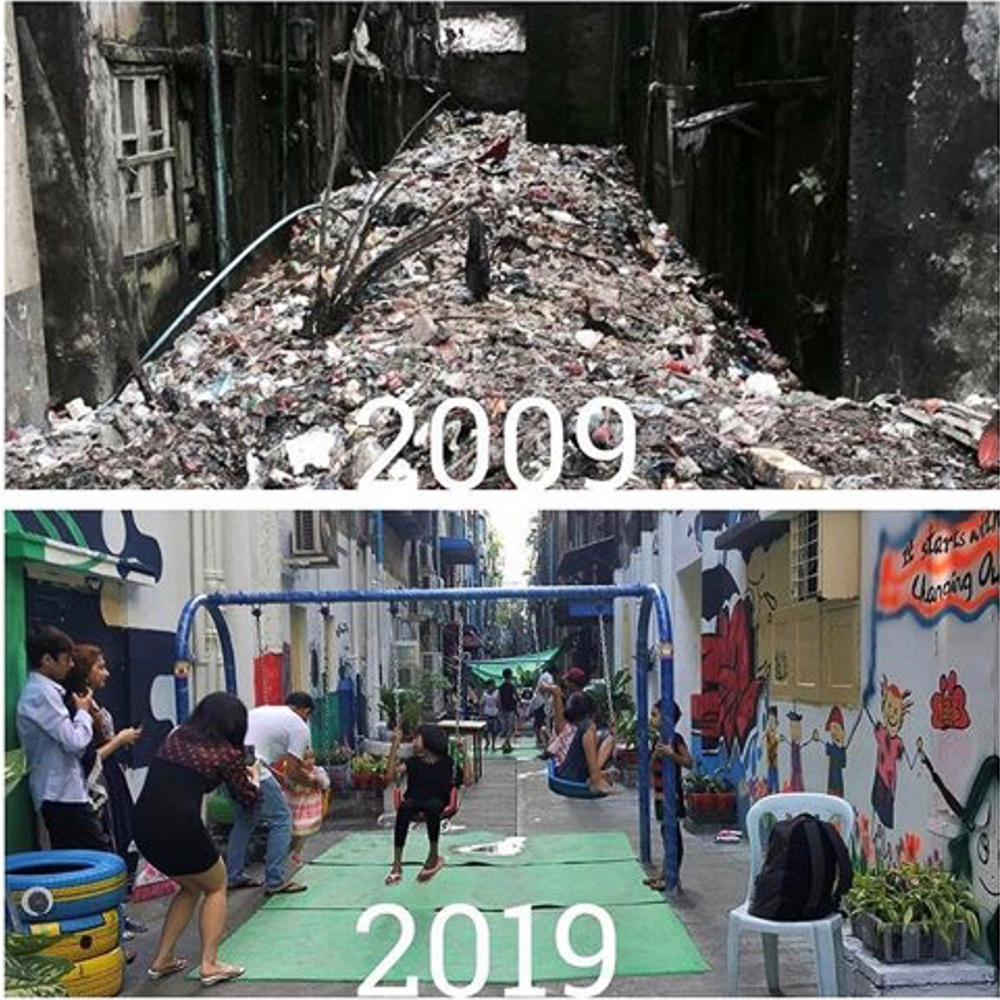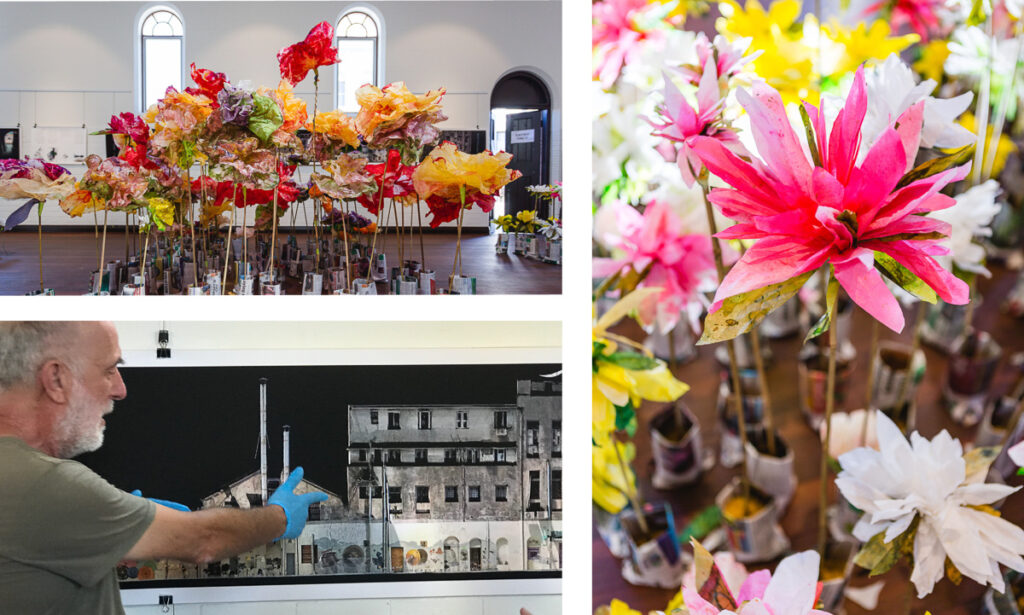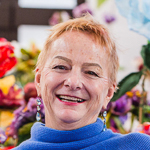
Flowermaking masterclass, photo Leonie Matthews; endemic Rose of Myanmar for cultural exchange, photo Marina Lommerse
Marina Lommerse documents exchange in flower making between old Yangon (Myanmar) and Fremantle (Western Australia).
Community art project and installation. 14 days. 100 community members. Four Australian creatives. 1000 paper flowers crafted and ‘planted’ down the 170-metre Yangon alley.
With an alleyway community in old Yangon, I led the crafting and “planting” of a thousand paper flowers, amid the crazy noise, heat, humidity, sand, construction, and general mayhem of a Myanmar city. Within a revitalised alley, we set up an outdoor workshop for two weeks. Alleyway residents, artists, interns, and passers-by were invited to craft flowers. Together we dyed paper, cut bamboo, made recycled newspaper plant pots and paper flowers, talked, and laughed. Over 14 days, the paper flower installation was “planted” down the 170-meter alleyway.
The community art project celebrated the transformation by locals of ten trash-filled alleyways in central Yangon into public open space with gardens, playgrounds, street art, and seating. Some 15,000 sqm of public space was reactivated as locals distanced themselves from 60 years of dictatorship, embracing democracy with civic engagement and a sense of ownership.

Before: trash-filled alleys bricked off for 30 years by the military. By 2020: 13 alleys were revitalised into public open spaces, facilitated by Doh Eain; photo: Doh Eain.
Stage 1: Community Consultation In Yangon 2019
Forty Yangon youth participated in Understanding Place Workshops facilitated by WA Spatialco Collaborative with Myanmar artists and photographers. Workshops, which informed Stage 2, included storytelling, photography, sketching, video, mapping.
Flowers play a central part in Burmese life. Daily, freshly cut flowers are offered to the Buddha at household and business shrines, temples and pagodas. Along the busy streets, women carry baskets of flowers for sale. Many native Myanmar flowers have been used for centuries for familiar cultivars such as hybrid tea roses, bred from the Rose of Myanmar, Rosa odorata gigantea. The botanical crafting installation fitted with Doh Eain’s vision of the Yangon Alley Gardens as a place for community gardens and public play, revealing the importance of flowers in Burmese culture, and the place of flowers in celebration.
Stage 2: Making Place Through Craft and Community in Yangon 2020
The communal mass production of paper flowers celebrated place, people and their social and cultural heritage. The aim was to bring together and strengthen the community of 600 residents and businesses that straddled the laneway. The new public space needed to be managed and cared for, and uses for the alleyways to be explored and activated.
We set up an outdoor workshop, with seating, tables, sunshades, tools, and materials. We planned to make a hundred flowers a day. This included making recyclable flowerpots, filling them with sand, and attaching recyclable bamboo “stems”. Daily, pre-school children enthusiastically constructed the flowerpots and planted flowers.

Yangon children making flower pots with Fergus of Spatialco, photo Marina Lommerse; Yangon pre-school children mounting the installation, photo Marina Lommerse
Daily, the paper was dyed and hung to dry to suit the colours and patterns required for the following day’s production.

Pete Hill of Spatialco drying paper, photo Marina Lommerse; Olivia, alley resident and high school student dying paper, photo Marina Lommerse; range of paper dyed and ready to cut, photo Marina Lommerse
The installation was mounted down the alley over the two weeks. Daily, the public and government officials strolled the alley to see the growing exhibition. Word spread, and Instagram-ers and fashionistas came to take their shots.

Twenty-something interns install the day’s flower, video Marina Lommerse; Leonie planting roses with interns, photo Marina Lommerse; Masterclass roses exhibition, Photo Marina Lommerse
The more complex flowers were made in masterclasses I facilitated. As part of the cultural and craft exchange between East and West, I selected endemic flowers from both countries to abstract.
We developed relationships with the community who joined in the making and the theatre of the growing installation, and we had a closing party instead of an opening event.
This recording at our closing event of the Yangon exhibition typifies the friendships and exchanges that developed over the project. The first day we set up in the alley, Anil, pictured, offered us the use of his power, water, and toilet for the duration, services not publicly available. His sister, Pushpa, visited daily to chat and bring us afternoon refreshments and Burmese specialties. He played the song ‘My flower, My flower’ for our goodbye dance.
Stage 3: Bringing Yangon Back To Australia, 2021
The project concluded with the Yangon Alley Garden exhibition in Fremantle. Drawings, stories, photographs, and an installation of 350 of the flowers “plucked” and brought back to Australia celebrated the cultural heritage and street life of Downtown Yangon.
The 3D Laser scanning by Peter Hill of the alley complete with the flower installation created a detailed visual record that was shared with Myanmar locals and Australian audiences. WA local creatives and youth participated in mounting the exhibition and in the design and production workshops in a professional knowledge exchange.

Yangon Alley Garden Exhibition, Old Mariners Gallery, Fremantle, photo Sundae Studio; Pete Hill explaining scans of the 170-metre alley installation, photo Marina Lommerse; Endemic WA everlastings, photo Sundae Studio
I ran flower crafting workshops as part of the Fremantle exhibition for local community members to learn paper flower crafting.
Along with other papercrafts, paper flower-making has been revived in the past decade, moving between craft and fine art. Local artisans in Myanmar have expressed the need for more support in technique and design. Our community art project aimed to get Yangon youth involved in art and craft and performance. Under military rule, education suffered from draconian policies. With the National League for Democracy (NLD) government, educational reform began, but there are few jobs, and the military coup in early 2021, together with the pandemic, has once more thrown a dark cloud over youth, education, and art.
Through the Yangon Alley Garden project, craft was used in a run-down alleyway to celebrate culture and community, to show how public spaces can be transformed. Yangon Alley became a workshop space, an exhibition space, a performance space, bringing together local people and artisans of diverse ages, education level, and vocation. A community once separated and stifled by a pile of disease-ridden trash became a joyful, colourful place of celebration and crafting.
An uncertain future
The community art project, funded by the Australian ASEAN Council, was a collaboration between WA’s Spatialco Consortium, of which Marina Lommerse was the artist partner, and Myanmar’s Doh Eain. This story was played out in the early days of the pandemic. Sadly, the continuation of the relationships between Eastern and Western artists and the initiative have been derailed by the military coup in the country. The Spatialco Consortium maintains communication with Doh Eain and the young creatives and community residents we worked with. Many are fighting on the frontline of the protests. We worry for their welfare.
Further reading
Doh Eain renewing Yangon (Doh Eain is a participatory design practice dedicated to making cities better. The NGO specializes in preserving heritage, creating and improving public spaces, and organising events, campaigns and workshops that connect people to places while empowering them to take part in shaping their city.)
M² Models and Methodologies for Community Engagement, Reena Tiwari, Marina Lommerse, Dianne Smith, (Eds.), Springer, 2014. (The book Includes essays from different voices, looking at how different fields engage community.)
“Working Together: Interior Architecture Creating with the Community,” pp. 15–40, Marina Lommerse, Perspectives on Social Sustainability and Interior Architecture, Springer, 2014. (This chapter explores how the author engages with community in her art and design practice.)
The Fine Art of Paper Flowers: A Guide to Making Beautiful and Lifelike Botanicals, Tiffanie Turner, Watson-Guptill, 2017. Tiffanie Turner is a fine artist and architect specializing in botanical-based sculpture and paper flowers.
Crafting forward to the village — Developing Crafts in Burma and South-East Asia, Emi Weir, Garland Magazine, 2017.
New Zero, Myanmar (The main objective is to develop Myanmar’s contemporary art community and to support the young generation of artists for the cultural future of society.)
About Marina Lommerse
 Marina Lommerse is a painter, muralist and installation artist. Her work tells stories, stirs the senses, and makes people smile. Her research and art practice focuses on placemaking, natural history, and cultural memory. She has exhibited and created murals and installations in Australia, Italy and Myanmar. She studied Natural History Illustration at the University of Newcastle and has a painting series of WA and Canadian arboreal forest wildflowers. Her botanical artwork extends into large-scale paper flower installations for The City of Claremont, FORM, Crown Resorts, and a community art making project in Myanmar. Formerly Associate Professor at Curtin University, she was the Founding Head, Department of Interior Architecture. Marina has a Master’s of Design and a Bachelor of Interior Architecture. Visit www.marinalommerse.com
Marina Lommerse is a painter, muralist and installation artist. Her work tells stories, stirs the senses, and makes people smile. Her research and art practice focuses on placemaking, natural history, and cultural memory. She has exhibited and created murals and installations in Australia, Italy and Myanmar. She studied Natural History Illustration at the University of Newcastle and has a painting series of WA and Canadian arboreal forest wildflowers. Her botanical artwork extends into large-scale paper flower installations for The City of Claremont, FORM, Crown Resorts, and a community art making project in Myanmar. Formerly Associate Professor at Curtin University, she was the Founding Head, Department of Interior Architecture. Marina has a Master’s of Design and a Bachelor of Interior Architecture. Visit www.marinalommerse.com



Comments
Well done Marina. A project of beauty. You are still as inspirational as I remember you when you were curating the Denmark woodies Perth exhibition in 2004, but now with a broader community arts focus. The flower making theme may seem more lightweight but the joyful pleasure it creates in the communities you work with is boundless.